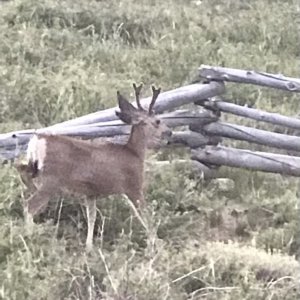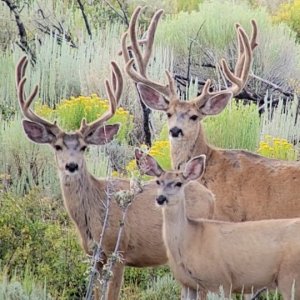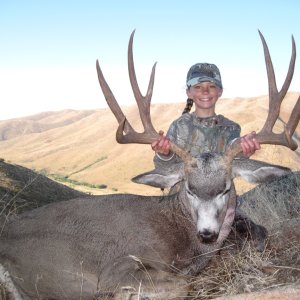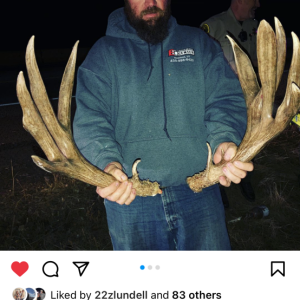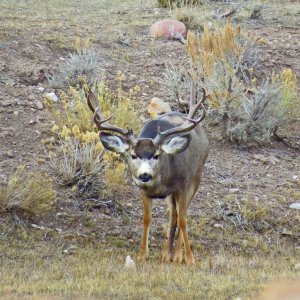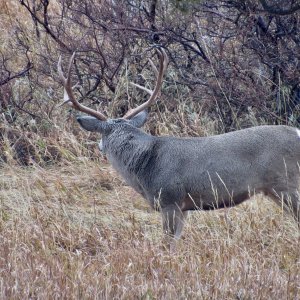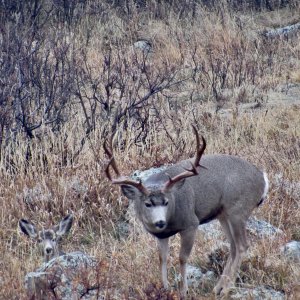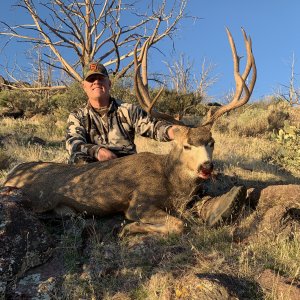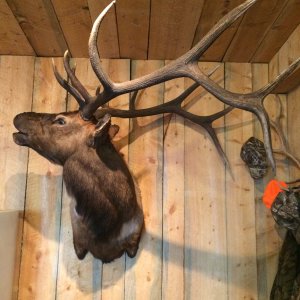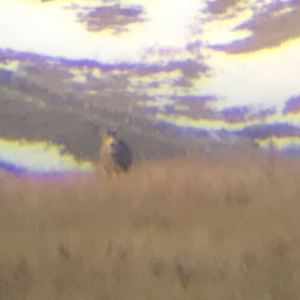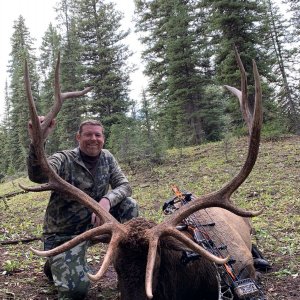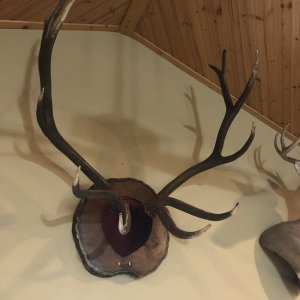I cant remeber if i ever posted this or not. If I have, then rip me a no one, but if I haven't then enjoy. It is my senior research paper.
Mule Deer: Genetics and Antler Development
Thesis Statement: Trophy mule deer bucks are scored using the Boone and Crockett scoring system, many factors can cause a buck to have trophy sized antlers, genetics is one of these factors.
I. Boone and Crockett scoring system
A. Measure points
B. Deductions
C. Typical/Non-typical
II. Antler purpose
A. Substances found in antlers
B. Where Substances in the antlers
III. Chemical composition
V. Antler size/ Body weight
VI. Old age
Manley 01
Mule Deer: Genetics and Antler Development
Since my first hunting excursion, when I was five years of age, when I saw my very first trophy sized mule deer, I have been interested and intrigued by mule deer antlers. I remember hearing my father, and his brother, my uncle Kevin, talking about some really large bucks that they had seen; here in Oregon, or in Wyoming and Colorado. I liked to sit and listen to them embellish the facts about the good old days of hunting, when harvesting a buck with a thirty five inch spread was not the most uncommon of experiences. Several years ago, my Uncle Kevin received a book for Christmas entitled, Wyoming?s Finest Mule Deer. This book further sparked my interest in mule deer bucks, due to some pictures of monster bucks found in this book. Some of the most famous bucks have been given names, such as Popeye or Morty. People, who was watched by the hunting community for many a year, was one of the largest mule deer bucks ever to live. A hunter never killed him.
As one of the most famous bucks of all time, Popeye inspired me in many ways to research mule deer. I have often wondered what makes the largest bucks such large
Manley 02
antlers, and why some areas produce larger bucks than others. I have always wanted to know why the state of Oregon produces few record book bucks, whereas Wyoming, Colorado, Nevada, and Utah produce huge bucks on a regular basis. Through my own research, magazine articles, and conversations with longtime hunters, I have come to the conclusion that there are many factors involved in producing big mature bucks, and genetics is one of these factors. I was finally presented with an opportunity to do some research on these specific questions. In my research I delved deep into the recesses of knowledge of one of the world?s foremost researchers of mule deer behavior and ecology, Dr. Velerius Geist. He presents several thesis? and theories about mule deer antler growth in his book Mule Deer Country, along with hard proven facts. I found that although many books are written on mule deer, and there behavior, few refer to genetics , or even antler growth as a whole. After search long and hard, I did find the sources I needed to support my thesis. Trophy mule deer bucks are scored using the Boone and Crocket scoring system, many factors can cause a big buck to have trophy sized antlers, genetics is one of these factors.
Manley 03
Since the foundation of the Boone and Crockett Club, by former President Theodore Roosevelt in the early part of the twentieth century, the club?s scoring system has been used as a standard for the measurement of mule deer antlers (Boone 1). There are two categories in this measurement system: typical and non-typical. The typical category, is for just that, typical buck, meaning bucks carrying a ?typical? set of antlers, with a four point bifurcated beam (two branches forking out from a main beam).
The Non-typical category is reserved for the most abnormal bucks, those with many points, and very unique, unstructured racks. For a typical buck, there are thirteen measuring points, all measured in inches. The scoring system uses the following measurements to find a total Boone and Crockett score:
The scoring system is a series of numbers, or a combination of letters and numbers assigned to each measuring point.
Beginning, Measurement A is the number of points, and Measurement B is the tip-to-tip spread, with Measurement C being the greatest spread between the two antlers. D is also a measurement spread, measuring the inside spread between the main beams (Boone and Crockett 1).
Manley 04
Moving on, E denotes the total length of all abnormal points, and F is the measurement of the length of both main beams.
Each point is given a G number according to its location on the main beam (i.e. G-1 is first point G-2 is second point, and so on).
Circumference measurements are given H numbers. H-1 is the circumference of the smallest place between burr (base of antler) and first point. H-2 is the circumference of smallest place between the first and second point. H-3 is the circumference of the smallest place between main beam and third point, and H-4 is the circumference of the smallest place between the second and fourth points (Boone and Crockett 1).
There are official scorers, whose job it is to measure these trophies for the hunters who harvested them. All measurements are made with a one fourth inch flexible steel tape, and are to the nearest one eighth of an inch (Boone and Crockett Club 1). Total measurements of the left antler are added to the total measurement of the right antler, and the total differences between the right and left are deducted. Non-Typical measurements are the same, but do not include deductions for abnormal points. The
Manley 05
minimum required score for a typical buck to be entered in the all-time record book the buck must score at least 190 or more inches (Boone and Crockett 1).
This explains what big antlers are, and how they are measured, but does not touch on what causes large antlers, or what their purpose is. ?Antler development is important for establishing dominance among males, and gaining access to mates? (Ditchkoff 616). To mule deer buck, nothing is more important than large antlers. They can provide dominance over smaller males, and they can attract females. Males advertise good genetics through sexual ornamentation and display. Female mate choice is based on sexual ornamentation, and the bigger a bucks antlers are, the more does he will have a chance to breed with (Ditchkoff 617). Does want buck with large antlers, because those traits are more likely to be passed on to her fawn, making it more likely to survive longer, and giving it a better chance to reproduce (Ditchkoff 617).
Pressing on, Antler size and mass reflect a buck?s survivor capabilities. Large antlers mean that the buck was better at obtaining the proper substances to support his fast growing antlers. His large antlers are passed on to his fawn, as are his abilities to gather necessary
Manley 06
substances for growth. ? The father?s ability to spare resources from growth express itself as large antlers, because antlers are universally highly sensitive to forage surpluses? (Geist 73).
Moving on, Antler characteristics (shape and uniqueness) Are readily passed on from generation to generation, but size (breadth and width) and mass (antler thickness and density) are not (Suttie 379, Evenden 520).
There are many substances found in antlers, the most prominent being the following: protein, collagen, lipids, ureic acid, sulfate acid, sialilic acid, ash, calcium, phosphorous, and magnesium (suttie 380). In a study of the chemical composition of different sections of antlers, it was found that ash content was lowest in the tip, and highest in the base. Lipids and proteins were highest in the tip, and lowest in the base. All minerals associated with calcification were highest in the base and lowest in the tip (Suttie 379). Genetics can have an effect on chemical composition.
Next, There is a definite correlation between antler size and bodyweight (Evenden 521). According to Dr. Giest, the larger the antlers of a breeding buck, the larger the birth weight of the fawn will be, making large
Manley 07
bucks more attractive to breeding females (Geist 73). The brow tines (points located directly above brow) are thought to be found only on the healthiest deer with the best genetics. Genetics often dictate the form in which aging bucks antlers develop (Geist 73).
Which brings us to our next few points. Each winter, after breeding is through, a buck cast his antlers. Soon after casting, or shedding, his antlers grow all over again.
During growth, they are covered in one of the fastest growing tissues in the animal world, a soft hairy skin-like covering known as velvet. During the cycle of growth, loss, and re-growth, many changes can take place from year to year. Some bucks also vary little from year to year (Geist 103).
There is a well know theory that old bucks often regress in antler growth. According to Geist, bucks antlers grow regularly larger, and longer, for up to eight years, then begin a cycle of regression. ? Antlers become more asymmetrical, and smaller, until the buck returns with only two long wavy spikes? (Geist 103). Big aging mule deer bucks have large regressed antlers, with lots of mass,
Manley 08
and long points. If the buck had a large four-point frame, he might revert back to a two or three point frame (Geist 103).
In addition, some areas Have better genetics, and a potential for bigger bucks than other areas. Wyoming has long been known for producing huge bucks, both typical and non-typical. Some of the bucks that have come from Wyoming?s region ?G? have set the par for trophy mule deer. Some of the largest and most respectable bucks have come from this area.
The worlds record mule deer, shot in Colorado in the 1960?s came from one of the best producing areas in the country. All areas are not the same. According to Dr. Geist, some bucks just cannot get big, in certain areas the largest bucks have only a two-point frame, but with a large spread (Geist 73). Some areas produce mostly 4 point, or abnormal, non-typical frames. There can also be genetic tendencies for some areas to produce many points. In this part of northeastern Oregon, there is a definite tendency for bucks to carry lots of points, and lots of mass, but not incredible spread of tine length.
Undernutrition for long periods of time, is capable of, and often does, inhibit antler growth. After a long,
Manley 09
harsh winter, such as the winter of 1992-1993, can cause bucks to grow thin antlers, with less mass (Evenden 522).
Next, according to suttie, scientists have been able to isolate two different alleles (genes) that effect antler growth in two different ways. One of these alleles effects tine length.
In conclusion, Genitecs play one of the largest roles in antler development. Mule deer bucks and does carry the genetic material that is needed to produce a trophy bucks. Mate choice, at least on the part of the female, is based almost entirely on antler size, making it possible for trophy genetics to easily be passed on from father to son; in turn making certain areas better Boone and Crockett areas than others. Answering the earlier questions of ?why do other states produce more trophy bucks than others.
Mule Deer: Genetics and Antler Development
Thesis Statement: Trophy mule deer bucks are scored using the Boone and Crockett scoring system, many factors can cause a buck to have trophy sized antlers, genetics is one of these factors.
I. Boone and Crockett scoring system
A. Measure points
B. Deductions
C. Typical/Non-typical
II. Antler purpose
A. Substances found in antlers
B. Where Substances in the antlers
III. Chemical composition
V. Antler size/ Body weight
VI. Old age
Manley 01
Mule Deer: Genetics and Antler Development
Since my first hunting excursion, when I was five years of age, when I saw my very first trophy sized mule deer, I have been interested and intrigued by mule deer antlers. I remember hearing my father, and his brother, my uncle Kevin, talking about some really large bucks that they had seen; here in Oregon, or in Wyoming and Colorado. I liked to sit and listen to them embellish the facts about the good old days of hunting, when harvesting a buck with a thirty five inch spread was not the most uncommon of experiences. Several years ago, my Uncle Kevin received a book for Christmas entitled, Wyoming?s Finest Mule Deer. This book further sparked my interest in mule deer bucks, due to some pictures of monster bucks found in this book. Some of the most famous bucks have been given names, such as Popeye or Morty. People, who was watched by the hunting community for many a year, was one of the largest mule deer bucks ever to live. A hunter never killed him.
As one of the most famous bucks of all time, Popeye inspired me in many ways to research mule deer. I have often wondered what makes the largest bucks such large
Manley 02
antlers, and why some areas produce larger bucks than others. I have always wanted to know why the state of Oregon produces few record book bucks, whereas Wyoming, Colorado, Nevada, and Utah produce huge bucks on a regular basis. Through my own research, magazine articles, and conversations with longtime hunters, I have come to the conclusion that there are many factors involved in producing big mature bucks, and genetics is one of these factors. I was finally presented with an opportunity to do some research on these specific questions. In my research I delved deep into the recesses of knowledge of one of the world?s foremost researchers of mule deer behavior and ecology, Dr. Velerius Geist. He presents several thesis? and theories about mule deer antler growth in his book Mule Deer Country, along with hard proven facts. I found that although many books are written on mule deer, and there behavior, few refer to genetics , or even antler growth as a whole. After search long and hard, I did find the sources I needed to support my thesis. Trophy mule deer bucks are scored using the Boone and Crocket scoring system, many factors can cause a big buck to have trophy sized antlers, genetics is one of these factors.
Manley 03
Since the foundation of the Boone and Crockett Club, by former President Theodore Roosevelt in the early part of the twentieth century, the club?s scoring system has been used as a standard for the measurement of mule deer antlers (Boone 1). There are two categories in this measurement system: typical and non-typical. The typical category, is for just that, typical buck, meaning bucks carrying a ?typical? set of antlers, with a four point bifurcated beam (two branches forking out from a main beam).
The Non-typical category is reserved for the most abnormal bucks, those with many points, and very unique, unstructured racks. For a typical buck, there are thirteen measuring points, all measured in inches. The scoring system uses the following measurements to find a total Boone and Crockett score:
The scoring system is a series of numbers, or a combination of letters and numbers assigned to each measuring point.
Beginning, Measurement A is the number of points, and Measurement B is the tip-to-tip spread, with Measurement C being the greatest spread between the two antlers. D is also a measurement spread, measuring the inside spread between the main beams (Boone and Crockett 1).
Manley 04
Moving on, E denotes the total length of all abnormal points, and F is the measurement of the length of both main beams.
Each point is given a G number according to its location on the main beam (i.e. G-1 is first point G-2 is second point, and so on).
Circumference measurements are given H numbers. H-1 is the circumference of the smallest place between burr (base of antler) and first point. H-2 is the circumference of smallest place between the first and second point. H-3 is the circumference of the smallest place between main beam and third point, and H-4 is the circumference of the smallest place between the second and fourth points (Boone and Crockett 1).
There are official scorers, whose job it is to measure these trophies for the hunters who harvested them. All measurements are made with a one fourth inch flexible steel tape, and are to the nearest one eighth of an inch (Boone and Crockett Club 1). Total measurements of the left antler are added to the total measurement of the right antler, and the total differences between the right and left are deducted. Non-Typical measurements are the same, but do not include deductions for abnormal points. The
Manley 05
minimum required score for a typical buck to be entered in the all-time record book the buck must score at least 190 or more inches (Boone and Crockett 1).
This explains what big antlers are, and how they are measured, but does not touch on what causes large antlers, or what their purpose is. ?Antler development is important for establishing dominance among males, and gaining access to mates? (Ditchkoff 616). To mule deer buck, nothing is more important than large antlers. They can provide dominance over smaller males, and they can attract females. Males advertise good genetics through sexual ornamentation and display. Female mate choice is based on sexual ornamentation, and the bigger a bucks antlers are, the more does he will have a chance to breed with (Ditchkoff 617). Does want buck with large antlers, because those traits are more likely to be passed on to her fawn, making it more likely to survive longer, and giving it a better chance to reproduce (Ditchkoff 617).
Pressing on, Antler size and mass reflect a buck?s survivor capabilities. Large antlers mean that the buck was better at obtaining the proper substances to support his fast growing antlers. His large antlers are passed on to his fawn, as are his abilities to gather necessary
Manley 06
substances for growth. ? The father?s ability to spare resources from growth express itself as large antlers, because antlers are universally highly sensitive to forage surpluses? (Geist 73).
Moving on, Antler characteristics (shape and uniqueness) Are readily passed on from generation to generation, but size (breadth and width) and mass (antler thickness and density) are not (Suttie 379, Evenden 520).
There are many substances found in antlers, the most prominent being the following: protein, collagen, lipids, ureic acid, sulfate acid, sialilic acid, ash, calcium, phosphorous, and magnesium (suttie 380). In a study of the chemical composition of different sections of antlers, it was found that ash content was lowest in the tip, and highest in the base. Lipids and proteins were highest in the tip, and lowest in the base. All minerals associated with calcification were highest in the base and lowest in the tip (Suttie 379). Genetics can have an effect on chemical composition.
Next, There is a definite correlation between antler size and bodyweight (Evenden 521). According to Dr. Giest, the larger the antlers of a breeding buck, the larger the birth weight of the fawn will be, making large
Manley 07
bucks more attractive to breeding females (Geist 73). The brow tines (points located directly above brow) are thought to be found only on the healthiest deer with the best genetics. Genetics often dictate the form in which aging bucks antlers develop (Geist 73).
Which brings us to our next few points. Each winter, after breeding is through, a buck cast his antlers. Soon after casting, or shedding, his antlers grow all over again.
During growth, they are covered in one of the fastest growing tissues in the animal world, a soft hairy skin-like covering known as velvet. During the cycle of growth, loss, and re-growth, many changes can take place from year to year. Some bucks also vary little from year to year (Geist 103).
There is a well know theory that old bucks often regress in antler growth. According to Geist, bucks antlers grow regularly larger, and longer, for up to eight years, then begin a cycle of regression. ? Antlers become more asymmetrical, and smaller, until the buck returns with only two long wavy spikes? (Geist 103). Big aging mule deer bucks have large regressed antlers, with lots of mass,
Manley 08
and long points. If the buck had a large four-point frame, he might revert back to a two or three point frame (Geist 103).
In addition, some areas Have better genetics, and a potential for bigger bucks than other areas. Wyoming has long been known for producing huge bucks, both typical and non-typical. Some of the bucks that have come from Wyoming?s region ?G? have set the par for trophy mule deer. Some of the largest and most respectable bucks have come from this area.
The worlds record mule deer, shot in Colorado in the 1960?s came from one of the best producing areas in the country. All areas are not the same. According to Dr. Geist, some bucks just cannot get big, in certain areas the largest bucks have only a two-point frame, but with a large spread (Geist 73). Some areas produce mostly 4 point, or abnormal, non-typical frames. There can also be genetic tendencies for some areas to produce many points. In this part of northeastern Oregon, there is a definite tendency for bucks to carry lots of points, and lots of mass, but not incredible spread of tine length.
Undernutrition for long periods of time, is capable of, and often does, inhibit antler growth. After a long,
Manley 09
harsh winter, such as the winter of 1992-1993, can cause bucks to grow thin antlers, with less mass (Evenden 522).
Next, according to suttie, scientists have been able to isolate two different alleles (genes) that effect antler growth in two different ways. One of these alleles effects tine length.
In conclusion, Genitecs play one of the largest roles in antler development. Mule deer bucks and does carry the genetic material that is needed to produce a trophy bucks. Mate choice, at least on the part of the female, is based almost entirely on antler size, making it possible for trophy genetics to easily be passed on from father to son; in turn making certain areas better Boone and Crockett areas than others. Answering the earlier questions of ?why do other states produce more trophy bucks than others.

